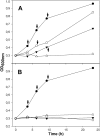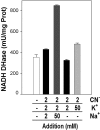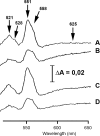Essential role of cytochrome bd-related oxidase in cyanide resistance of Pseudomonas pseudoalcaligenes CECT5344
- PMID: 17574992
- PMCID: PMC1950984
- DOI: 10.1128/AEM.00503-07
Essential role of cytochrome bd-related oxidase in cyanide resistance of Pseudomonas pseudoalcaligenes CECT5344
Abstract
Pseudomonas pseudoalcaligenes CECT5344 grows in minimal medium containing cyanide as the sole nitrogen source. Under these conditions, an O2-dependent respiration highly resistant to cyanide was detected in cell extracts. The structural genes for the cyanide-resistant terminal oxidase, cioA and cioB, are clustered and encode the integral membrane proteins that correspond to subunits I and II of classical cytochrome bd, although the presence of heme d in the membrane could not be detected by difference spectra. The cio operon from P. pseudoalcaligenes presents a singular organization, starting upstream of cioAB by the coding sequence of a putative ferredoxin-dependent sulfite or nitrite reductase and spanning downstream two additional open reading frames that encode uncharacterized gene products. PCR amplifications of RNA (reverse transcription-PCR) indicated the cyanide-dependent up-regulation and cotranscription along the operon. The targeted disruption of cioA eliminates both the expression of the cyanide-stimulated respiratory activity and the growth with cyanide as the nitrogen source, which suggests a critical role of this cytochrome bd-related oxidase in the metabolism of cyanide by P. pseudoalcaligenes CECT5344.
Figures





Similar articles
-
Putative small RNAs controlling detoxification of industrial cyanide-containing wastewaters by Pseudomonas pseudoalcaligenes CECT5344.PLoS One. 2019 Feb 8;14(2):e0212032. doi: 10.1371/journal.pone.0212032. eCollection 2019. PLoS One. 2019. PMID: 30735537 Free PMC article.
-
Characterization of the Pseudomonas pseudoalcaligenes CECT5344 Cyanase, an enzyme that is not essential for cyanide assimilation.Appl Environ Microbiol. 2008 Oct;74(20):6280-8. doi: 10.1128/AEM.00916-08. Epub 2008 Aug 15. Appl Environ Microbiol. 2008. PMID: 18708510 Free PMC article.
-
DNA microarray analysis of the cyanotroph Pseudomonas pseudoalcaligenes CECT5344 in response to nitrogen starvation, cyanide and a jewelry wastewater.J Biotechnol. 2015 Nov 20;214:171-81. doi: 10.1016/j.jbiotec.2015.09.032. Epub 2015 Sep 30. J Biotechnol. 2015. PMID: 26432339
-
Metabolic adaptation of Pseudomonas pseudoalcaligenes CECT5344 to cyanide: role of malate-quinone oxidoreductases, aconitase and fumarase isoenzymes.Biochem Soc Trans. 2011 Dec;39(6):1849-53. doi: 10.1042/BST20110714. Biochem Soc Trans. 2011. PMID: 22103538 Review.
-
Bacterial cyanide degradation is under review: Pseudomonas pseudoalcaligenes CECT5344, a case of an alkaliphilic cyanotroph.Biochem Soc Trans. 2011 Jan;39(1):269-74. doi: 10.1042/BST0390269. Biochem Soc Trans. 2011. PMID: 21265786 Review.
Cited by
-
Role of the Dihydrodipicolinate Synthase DapA1 on Iron Homeostasis During Cyanide Assimilation by the Alkaliphilic Bacterium Pseudomonas pseudoalcaligenes CECT5344.Front Microbiol. 2020 Jan 23;11:28. doi: 10.3389/fmicb.2020.00028. eCollection 2020. Front Microbiol. 2020. PMID: 32038602 Free PMC article.
-
Deciphering Cyanide-Degrading Potential of Bacterial Community Associated with the Coking Wastewater Treatment Plant with a Novel Draft Genome.Microb Ecol. 2015 Oct;70(3):701-9. doi: 10.1007/s00248-015-0611-x. Epub 2015 Apr 26. Microb Ecol. 2015. PMID: 25910603
-
Putative small RNAs controlling detoxification of industrial cyanide-containing wastewaters by Pseudomonas pseudoalcaligenes CECT5344.PLoS One. 2019 Feb 8;14(2):e0212032. doi: 10.1371/journal.pone.0212032. eCollection 2019. PLoS One. 2019. PMID: 30735537 Free PMC article.
-
A Case of Adaptive Laboratory Evolution (ALE): Biodegradation of Furfural by Pseudomonas pseudoalcaligenes CECT 5344.Genes (Basel). 2019 Jun 29;10(7):499. doi: 10.3390/genes10070499. Genes (Basel). 2019. PMID: 31261932 Free PMC article.
-
Alternative Pathway for 3-Cyanoalanine Assimilation in Pseudomonas pseudoalcaligenes CECT5344 under Noncyanotrophic Conditions.Microbiol Spectr. 2021 Dec 22;9(3):e0077721. doi: 10.1128/Spectrum.00777-21. Epub 2021 Nov 3. Microbiol Spectr. 2021. PMID: 34730416 Free PMC article.
References
-
- Baughn, A. D., and M. H. Malamy. 2004. The strict anaerobe Bacteroides fragilis grows in and benefits from nanomolar concentrations of oxygen. Nature 427:441-444. - PubMed
-
- Berthold, D. A., and P. Stenmark. 2003. Membrane-bound diiron carboxylate proteins. Annu. Rev. Plant Biol. 54:497-517. - PubMed
-
- Crane, B. R., and E. D. Getzoff. 1996. The relationship between structure and function for the sulfite reductases. Curr. Opin. Struct. Biol. 6:744-756. - PubMed
-
- Cunningham, L., M. Pitt, and H. D. Williams. 1997. The cioAB genes from Pseudomonas aeruginosa code for a novel cyanide-insensitive terminal oxidase related to the cytochrome bd quinol oxidases. Mol. Microbiol. 24:579-591. - PubMed
Publication types
MeSH terms
Substances
Associated data
- Actions
LinkOut - more resources
Full Text Sources
Medical
Molecular Biology Databases

